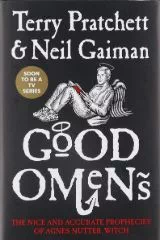Frankenstein by Mary Shelle...
Frankenstein is not the name of the monster,...
By Adonis Monahan1825

0

It wasn’t a dark and stormy night when the creation began. In fact, it was a nice day. Hopefully, all days will be nice as you read your way through Good Omens and figure out what to do when you realize that the end is really nigh.
Put down your books if you are an angel and call for your demon friend, or if you happen to be that diabolic entity, call your angel friend and tell him that your mutual love for life as you both know it necessitates stopping the apocalypse, as Freddie Mercury screams out on the radio: “Scaramouche, Scaramouche, will you do the Fandango!”
Good Omens is a story of not just an angel and a demon trying to stop the end of the world, but it is about a witch, a witchfinder, an antichrist and his friends, and a couple of unpleasant people.
As you would probably find from the first few pages of the book, Good Omens is filled to the brim with Terry Pratchett’s familiar tone of humor—British humor if that’s your cup of tea—and it sets a very light atmosphere despite the grim happenings of the story.
Footnotes are a signature writing style of Pratchett’s. He incorporates them into his novels without intruding on the stream of events.
He provides crucial information in footnotes, addressing the readers directly without cluttering the text of the story, though he does that in Good Omens with a note of hilarity. Neil Gaiman’s brilliance shows as well, mainly in the worldbuilding that his fans are familiar with.
The unusual narrative of the story could be a great study for the absurdist fiction readers and writers (and also spectators who’ll recognize and have a laugh at the familiar language in this book).
Good Omens constitutes a great material for this unique genre and it’s special as it depicts absurdism from a fantasy, supernatural point of view. So, for readers who want to try reading absurdist/fantasy novels, Good Omens is an exemplary book in this regard.
Updated 3 years ago